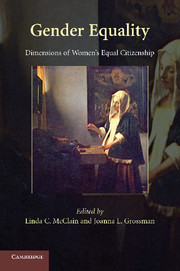Book contents
- Frontmatter
- Contents
- Contributors
- Acknowledgments
- Gender Equality
- Introduction
- PART I CONSTITUTIONAL CITIZENSHIP AND GENDER
- PART II POLITICAL CITIZENSHIP AND GENDER
- 6 Women and Antiwar Protest: Rearticulating Gender and Citizenship
- 7 Stem Cells, Disability, and Abortion: A Feminist Approach to Equal Citizenship
- 8 Representation, Discrimination, and Democracy: A Legal Assessment of Gender Quotas in Politics
- 9 Citizenship and Women's Election to Political Office: The Power of Gendered Public Policies
- PART III SOCIAL CITIZENSHIP AND GENDER
- PART IV SEXUAL AND REPRODUCTIVE CITIZENSHIP
- PART V GLOBAL CITIZENSHIP AND GENDER
- Suggested Readings
- Index
- References
8 - Representation, Discrimination, and Democracy: A Legal Assessment of Gender Quotas in Politics
Published online by Cambridge University Press: 05 August 2012
- Frontmatter
- Contents
- Contributors
- Acknowledgments
- Gender Equality
- Introduction
- PART I CONSTITUTIONAL CITIZENSHIP AND GENDER
- PART II POLITICAL CITIZENSHIP AND GENDER
- 6 Women and Antiwar Protest: Rearticulating Gender and Citizenship
- 7 Stem Cells, Disability, and Abortion: A Feminist Approach to Equal Citizenship
- 8 Representation, Discrimination, and Democracy: A Legal Assessment of Gender Quotas in Politics
- 9 Citizenship and Women's Election to Political Office: The Power of Gendered Public Policies
- PART III SOCIAL CITIZENSHIP AND GENDER
- PART IV SEXUAL AND REPRODUCTIVE CITIZENSHIP
- PART V GLOBAL CITIZENSHIP AND GENDER
- Suggested Readings
- Index
- References
Summary
Introduction: Scenes of Switzerland
In Switzerland, women were not enfranchised on the federal level until 1971. Of twenty-six cantons, the last to allow women to vote in cantonal elections was Appenzell-Innerrhoden in 1990. This reform was not made through legislative processes, but only after female citizens complained to the Swiss Federal Supreme Court.
Despite late enfranchisement, citizens in Swiss cantons actively campaigned for delegate quotas, particularly during the 1990s. Although ultimately unsuccessful, campaigns aimed at delegate quotas for women for federal political offices and in two cantons, Solothurn and Uri. In the Swiss system of direct democracy, cantonal initiatives are scrutinized for their compatibility with the federal constitution before they are submitted to the people for a popular vote. Regarding the two cantonal quota initiatives, the Swiss Federal Supreme Court issued decisions in 1996 and 1998. In its first decision, the Federal Supreme Court considered a far-reaching proposal to reserve 50 percent of the seats of all elected offices in the legislative, executive, and judicial branches in Solothurn for women. The proposal requested that all open positions be earmarked for the underrepresented sex until men and women were represented “according to their proportion in the canton's population.” The Court found this bill manifestly unconstitutional due to its “obvious disproportionality” in curtailing active and passive voting rights.
In its second judgment, the Federal Supreme Court partly upheld a more moderate initiative in Uri.
- Type
- Chapter
- Information
- Gender EqualityDimensions of Women's Equal Citizenship, pp. 174 - 200Publisher: Cambridge University PressPrint publication year: 2009
References
- 1
- Cited by

